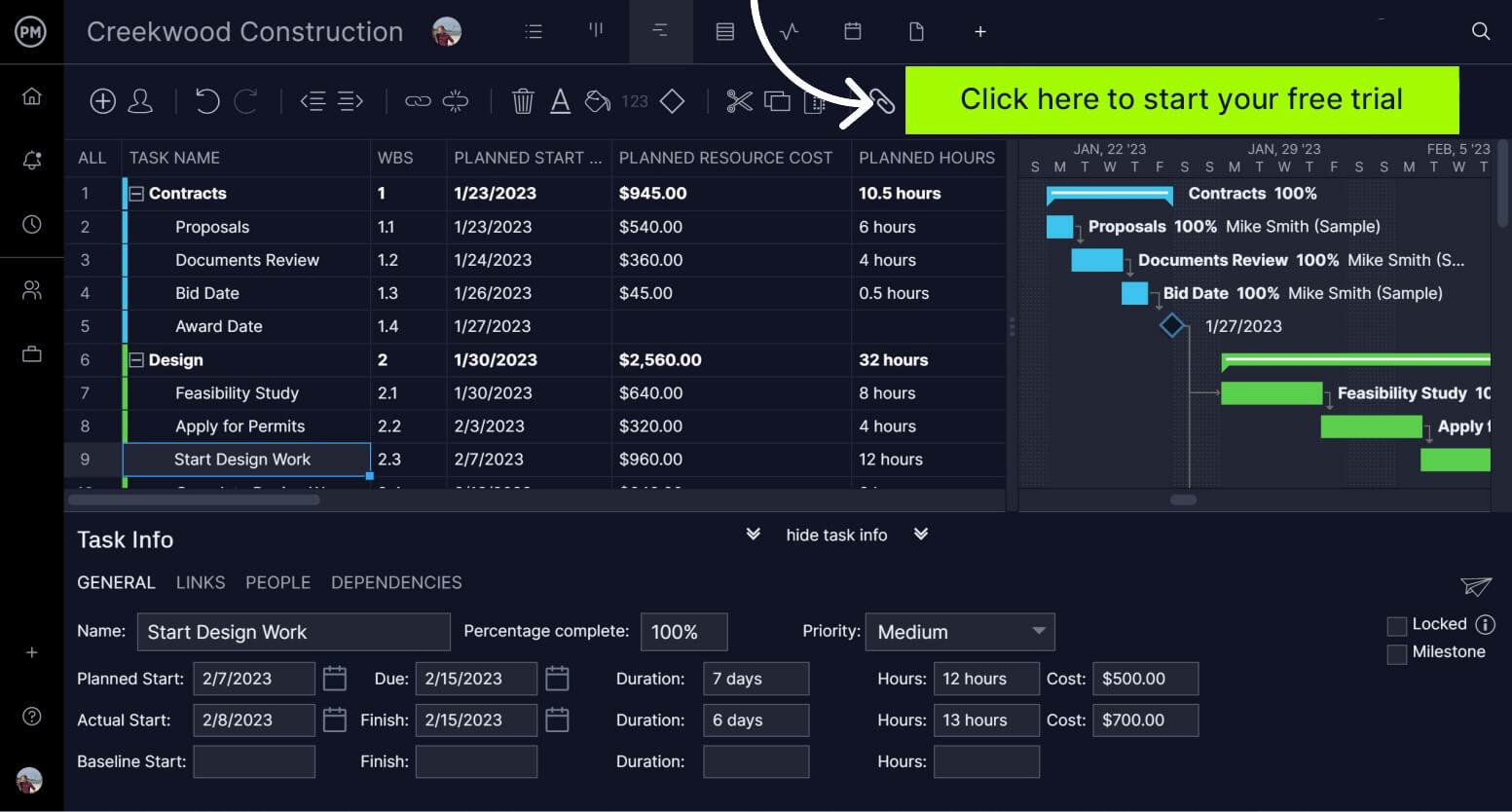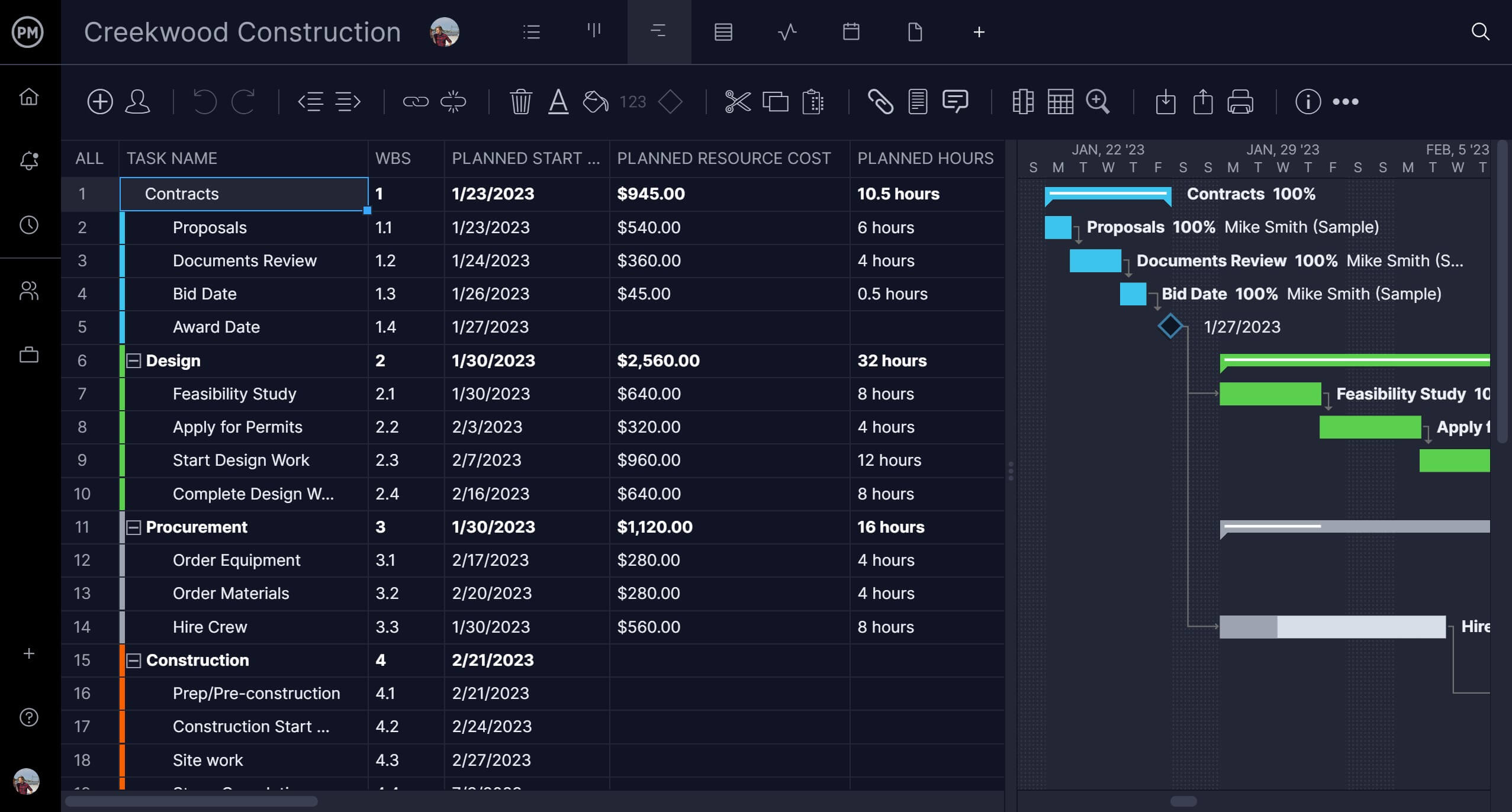Projects are made up of many moving parts. One of the ways that you can determine if the project is behind or ahead of schedule is called schedule control.
Project planning, scheduling and control all go together when managing a project to stay on time and meet your deadlines. Learning what schedule control is and what you can do to best apply it can help you bring your next project in on-time and under budget.
What Is Schedule Control?
Schedule control is used in project management to monitor your activities and tasks to ensure you’re proceeding as planned. Of course, it’s more than just monitoring status. Project schedule control also means updating your project processes and managing change.
The most common way to do this is by creating a baseline. A baseline represents how you expect the project to proceed. When you have a schedule baseline, you can look at your actual progress and compare it to the planned progress, which lets you know if you’re ahead or behind schedule.
This whole process is simplified with the help of project scheduling software like ProjectManager. ProjectManager lets you build a project schedule, set a baseline and track progress in real time. It’s never been easier to keep your schedule under control.

Schedule control is part of the larger project management process of controlling and monitoring. That is, projects need to be closely watched, and as change occurs, which it will, those changes must be proactively controlled. This is the purview of the project manager, who created the schedule and is responsible for executing it.
Why Is Project Schedule Control Important?
Project schedule control is essential because it is used to monitor and control the progress of the project. A project that misses its deadline is not a success. While there are many metrics to measure the success of a project, keeping to the schedule is among the most fundamental.
Another important aspect of schedule control is that it manages the expectations of your project stakeholders. It keeps them informed of changes and how they will impact the project. Furthermore, it tells the stakeholders how you’re going to respond to issues to get the project back on track. This process is key to keeping stakeholders in the loop and should be done throughout the life cycle of the project.
Project planning, scheduling and control work hand-in-glove to reduce the impact on your budget. The benefit is financial stability, which projects need to deliver at a cost that has been approved by stakeholders. It also creates documentation that can be helpful when researching historical data for future projects similar to the one you’re managing currently.
Who Manages Schedule Control?
Schedule control is a collaborative effort, but specific roles within an organization are primarily responsible for managing and maintaining it. The project manager will oversee the project schedule and track progress against the actual schedule. If there are any schedule variances, the project manager will implement the needed changes to get the project back on track as quickly as possible.
If the project is larger, a dedicated project scheduler or planner may oversee the technical aspects of schedule control. For example, they analyze scheduling data, generate reports, identify the critical path and help the project manager schedule recovery plans.
A team member interacts with schedule control through their assigned tasks and communication with the project manager or team lead. They would complete tasks assigned to them within the specified timeframe and provide task status updates for the project manager.
When Does Schedule Control Matter Most?
The schedule control matters throughout the project. Stakeholders will want to know the state of the schedule, from the moment it’s created to when the project has been completed. Therefore, it should be baked into your schedule as you develop it.
Of course, it’s most important when you begin executing the schedule. This is when the schedule is no longer an abstraction, but a practical tool to execute tasks on time and within budget. It is during the execution phase of a project that your schedule will be impacted by internal and external forces that could potentially derail your progress.
Monitoring and controlling the schedule occurs throughout the execution, from the start of the first task to the finish of the last. However, while this is when schedule control matters most, it is never finished. Document your changes during execution: the way you responded to them and the results are key to this phase in the project.
Related: Project Scheduling Templates
How to Do Schedule Control in Project Management
Schedule control in project management is a way to make sure the schedule is going as planned. There are five steps in this process:
- Set standards: In order to know if the schedule is not being met, you need to set standards. That is, you have to determine the metrics by which you’ll measure the performance of your project.
- Measure performance: As the schedule is being executed, you need to get data on its progress and keep records. Measurement is crucial. Being able to measure the performance of your schedule is how you compare it to the baseline. A dashboard can help.
- Compare your results: Compare your measurement of the project’s progress against that baseline you created. As you make these regular comparisons, you want to be alert for any deviations. Identify them, for they are crucial to the next step.
- Determine Issues: Once you have identified a deviation from the baseline, the next step is to figure out why that happened. Only by determining the reason behind the change can you work out a proper plan to respond and resolve it.
- Take action: Take up action to correct the issue as needed. This can be done by adjusting revenue, cost, profits, product, time, resources and so forth.
8 Schedule Control Techniques when Planning & Scheduling
The best way to implement schedule control is by applying techniques to help you monitor and manage change. Here are eight:
- Performance Reviews: Use this to measure, compare and analyze the performance of your schedule. There are several ways to select the performance you want to review, such as the actual start and finish dates, percent complete and remaining duration for the work in progress. These reviews can help result in performance improvement such as mentoring or additional training to boost individual performance.
- Critical Path Method: The critical path helps you predict how long the project will take by analyzing the sequence of activities and discovering which are essential, and which you can skip and still deliver the project successfully. If there are potential schedule delays, project managers can develop mitigation strategies.
- Monte Carlo Simulation: This technique helps you quantify the total cost of your project, which allows you to calculate a defined distribution of total costs for the project and possible completion dates. By simulating various scenarios, this simulation helps identify potential schedule risks and how they impact the project.
- Resource Histogram: By using a resource histogram, you can show resource consumption and availability by time period. They also reveal periods of under-allocation to note when resources aren’t being used effectively.
- Variance Analysis: The variance is the difference between the planned and actual schedule of your project. This analysis helps you to determine the cause of the variance. If there is a positive analysis, the project is ahead of schedule while a negative variance indicates it’s behind schedule.
- Work Breakdown Structure (WBS): A work breakdown structure helps break down the project schedule into smaller and more manageable tasks. This results in more accurate time estimates and progress tracking.
- Resource Leveling: This schedule control tip aims to optimize resource allocation and prevent resource-related delays. It identifies periods of over-allocation where resources are assigned to too many tasks simultaneously, helping to improve schedule stability.
- Contingency Planning: Use this to identify potential schedule risks and their impact on the project’s timeline. Contingency planning accounts for potential delays and unexpected events, reducing the impact of risks on the project schedule.
Free Schedule Control Templates
Schedule control is an essential part of project management. If you’re not ready to use project management software, consider our free schedule control templates. These are only a handful of the many free project management templates available on our site.
Gantt Chart Template
Our free Gantt chart template for Excel makes it easy to plan and track complex projects. It uses a pre-defined structure to help organize project tasks, timelines and milestones that make up the project plan. Use it to spot issues and take action quickly.
Critical Path Template
To keep track of the project’s completion date, use our free critical path template for Excel. It’s an efficient way to visualize the longest, most important chain of tasks that must be completed to deliver the project successfully.
PERT Chart Template
Use this free PERT chart template to visually represent the project timeline. It helps estimate the minimum time needed to complete a project. A PERT chart helps illustrate dependent tasks, make a project timeline and calculate the critical path.
How ProjectManager Helps with Schedule Control
These techniques are all helpful, but to better monitor and track your progress and control the schedule, you need to use project management software. ProjectManager is a cloud-based tool that captures live information to help project managers make better and more insightful decisions.
Build Dynamic Schedules on Gantt Charts
Our interactive Gantt chart serves a powerful tool to schedule your projects. Unlike less powerful tools that only set priority, link dependencies and add milestones, you can also filter for the critical path and set project baselines instantly.

Track Your Schedule with a Dashboard
Monitoring and tracking are a necessity for project schedule control. You need to see your actual progress in real time and act quickly when it deviates from the plan. Get a high-level view with our no-setup-required dashboard. The dashboard captures several project metrics, including variance, and displays the automated results in easy-to-read graphs and charts.

Use In-Depth Reports to Analyze Issues
Sometimes you want a deeper view of the data. That’s where our one-click reports on variance, cost and much more come in handy. All the reports can be filtered to show just the information you want to see. Then, print or share the results as a PDF. This is great for managing stakeholders’ expectations and keeping them up-to-date.

Those are just a few of ProjectManager’s features that can help you with schedule control. There’s also automated alerts, resource management tools and timesheets to track the time your team spends on their tasks. Plus, teams can use multiple views, so everyone gets to work the way they want. Why bother with a handful of apps when one can do the trick of delivering quality on time and within budget?
ProjectManager is award-winning software that organizes tasks, teams and projects. It has features to help you throughout every phase of a project, from planning to monitoring and reporting. Join the tens of thousands of teams at organizations from NASA to Ralph Lauren who is using our tool to deliver their projects. Try ProjectManager today.

